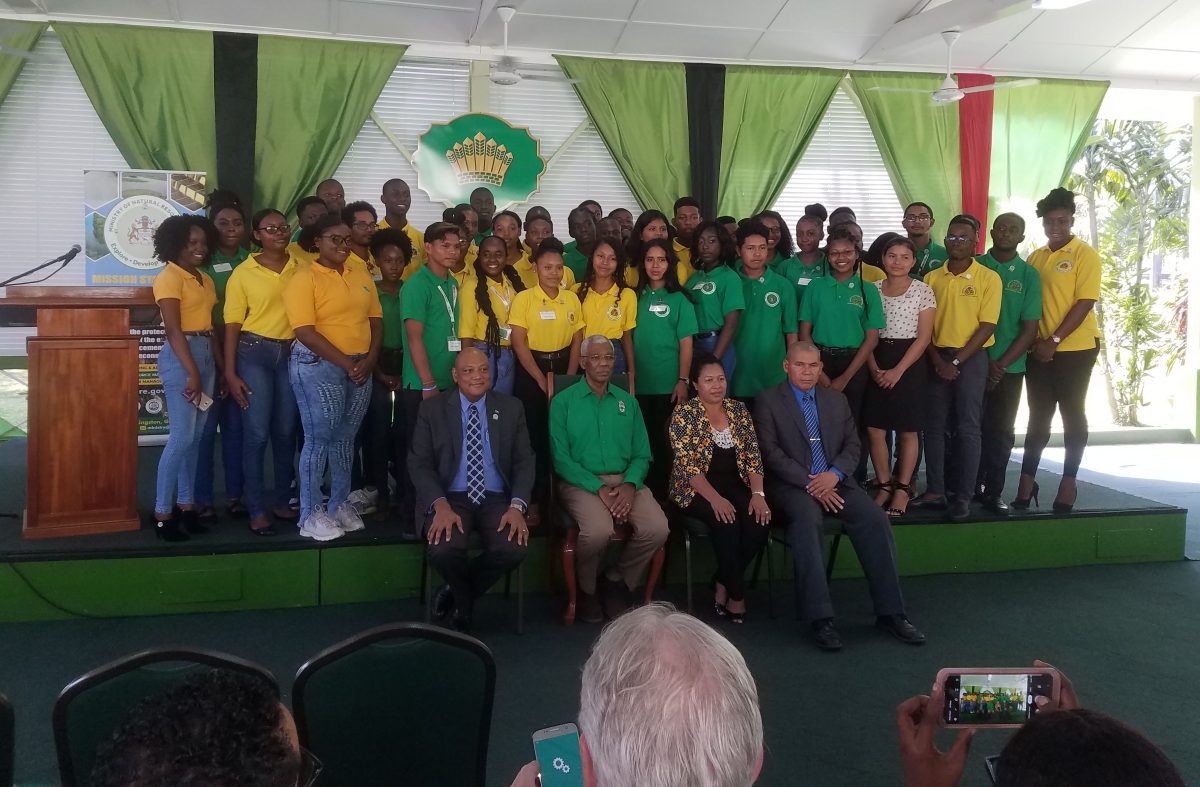Another group of youths yesterday graduated from the third ‘Youth in Natural Resources’ apprenticeship programme.
The three-week programme is an initiative of the Ministry of Natural Resources and at a closing ceremony held at the Baridi Benab, State House, the 28 apprentices were presented with certificates and welcomed into the programme’s alumni body.
The objective of the programme was to involve youth in the protection and preservation of Guyana’s natural resources. Over the three-week period, the participants were given the opportunity to visit and travel along the Berbice River and the savannahs of the Rupununi and Lethem.
According to Minister of Natural Resources Raphael Trotman, the students would have been given the opportunity to visit and see for themselves the operations of various entities and organisations that are involved in various aspects of the natural resources sector in Guyana. “You have received an overview and visited the operations of the Guyana Geology and Mines Commission and the mining school, the Guyana Forestry Commission, the Guyana Gold Board…you have visited mining operations at Bosai…you have seen our sand resources at the sandpit,” he said, as he gave an overview of the activities that the students took part in over the three-week period.
Trotman said that he was pleased to witness the completion of the programme by another batch of students. “You have been chosen by the government and we have trained you. Your country needs you, your government needs you,” Trotman said, as he bid the students farewell and congratulated them for successfully completing the programme.
Giving the feature address at the closing ceremony, President David Granger congratulated the students on their completion of the programme. In his address, the president sought to enlighten the youths and those at the gathering about Guyana’s abundant natural resources. He observed that Guyana is known as the habitat for some of the rarest flora and fauna in the world. He noted that approximately 75 per cent of Guyana’s territory is still covered with forests which provides mitigation for the effects of greenhouse gas emissions.
“The shield (Guiana Shield) reminds us that natural resources are not confined to the extractive industries. Renewable resources such as our forest and biodiversity, all natural resources, all of them are the patrimony of all Guyanese. They are and will continue to be used for the benefit of present and future generations,” the president said.
He went on to say that we are merely trustees or custodians and what we inherited from our parents and foreparents we must take care of so that we will be able to pass it on to the generations to come. “Guyana is rich in agricultural, forestry and mineral resources, these resources including bauxite, diamonds, fisheries, gold, rice, sugar and timber have been the mainstay of our economy for more than 100 years, maybe 200 years…agriculture, fisheries, forestry and mining up to the present time, account for almost one third of the country’s GDP,” Granger added.
The president said that the development of natural resources must be sustainable and consistent. He said that the concept of sustainable development is critical to understanding the need to protect the environment while providing for human survival. He stated that after becoming president, he would have signed on to the Paris Agreement where he promised to set aside an additional two million hectares of Guyana’s territory for conservation purposes.
One student who was part of the apprenticeship programme, Miriam Ogle, told Stabroek News that the programme lasted for about three weeks and they would have had a chance to visit various operations of extractive industries. “We went to Iworkrama. From there, we went to Lethem where we crossed the Takutu Bridge for a while. We also went to Kwakwani,” Ogle said. She added that her favorite part of the traveling was the visit to the canopy walkway. “It was very scary because I don’t really like heights, but I did it. It was rough but I did it,” she said. She recalled that she was initially to be a part of last year’s batch of students but did not regret the decision to wait another year and be a part of the “Youths in Natural Resources III”.
While Ogle is not quite sure of what she would like to do in the future, her exposure to the natural resources operations has her considering a career in the sector.






